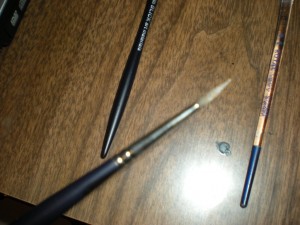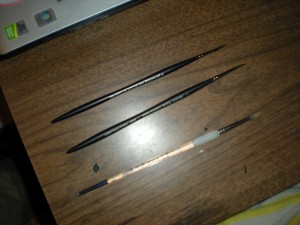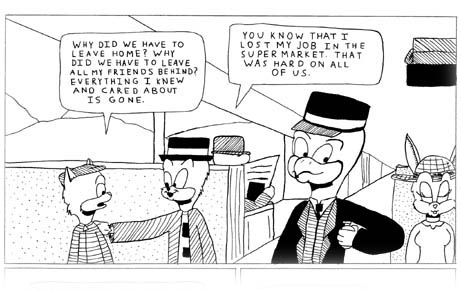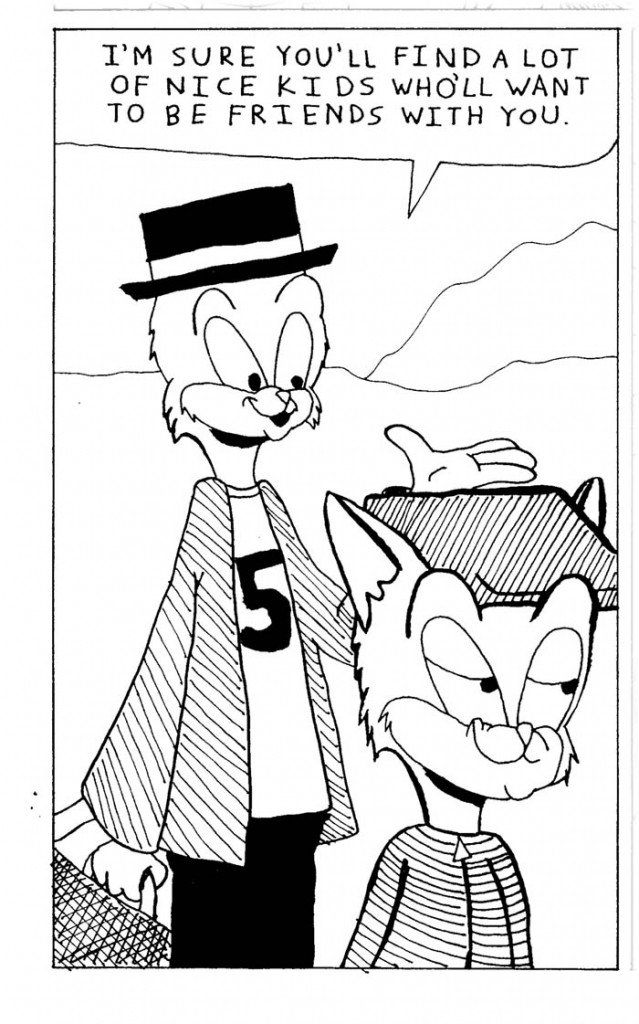When it comes to inking, I’m a lover of the pen. I use dip pens and technical pens chiefly in my work. The pen is easier to use and can be a quicker route to a paying livelihood. However, if you feel bold and you really want more expressive lines, there is a tool that you can use for that. That tool is…the brush!
There are many a gifted user of the brush when it comes to comics. Bill Watterson of Calvin and Hobbes and the immortal Walt Kelly of Pogo produced beautifully rendered lines in their comics using brushes. Jeff Smith, Daniel Clowes, and Jack Kirby are even more examples of those who use brushes in their work. Take a look at their comics to see what I’m talking about.
Check your local art supply stores for brushes. Your choice should be a watercolor brush which is small enough to fit in your hand. Stay away from any brushes labeled for use with oils or acrylics – those often have long handles. The best kinds of brushes are sable brushes, made with the hairs from the Kolinsky sable. Unfortunately these can be pricey. Brushes like these will often start at US$20 and go up. One of the top choices of comics professionals are the Winsor Newton Series 7 sable brushes. Others like the brands Raphael or Rekab. Synthetic brushes can be a good choice too and for those of you on a budget, the Winsor Netwon Sceptre Gold II series is a solid inking tool. Do yourself a favor and try not to get the cheapest brushes out there. Those will fall apart on you in no time. Brushes will come in different sizes – this is indicated by the number you’ll see on their handles. The bigger the number, the bigger the brush. A beginning inker should stick to a size 3 and smaller.
So what sort of brushes do I use? I have three sizes of Winsor Newton brand Artist Sable Watercolor brushes – sizes 1,3, and 4. I keep a cheap size 5 round brush for filling in big areas of black.
You’ll also need a water container to dip your brush in before use and to clean off your brush in between uses. When you finish using your brush for the day, you’ll need something else to clean it. I advise buying a container of brush cleaner – a special soap usually in a tub pictured here meant to clean off ink and paint. Follow the directions on the cleaner and your brushes should last a long time. Even with the most vigorous care, brushes will eventually wear out. Don’t throw away worn brushes however – save them for neat effects. Many pros out there will have a whole jar full of old brushes they use for special effects and unique textures.
You’ll also need a bottle of ink to dip the brush in. Refer back to my post on inking comics for more information on what sort of ink to use. My choice of black ink is Speedball Super Black India ink. It’s waterproof and gives a good black on the page.
 Brushes consist of three basic parts – a handle (self-explanatory), a ferrule, and the hair itself. The ferrule is the metal part that is used to hold the hairs in place. Never ever use hot water to clean your brushes. That will expand the ferrule and will make the hairs fall out. When you store the brush, store it with the hairs pointing up. Do NOT store the brush with the hairs down – this will misshape the brush and make it unusable.
Brushes consist of three basic parts – a handle (self-explanatory), a ferrule, and the hair itself. The ferrule is the metal part that is used to hold the hairs in place. Never ever use hot water to clean your brushes. That will expand the ferrule and will make the hairs fall out. When you store the brush, store it with the hairs pointing up. Do NOT store the brush with the hairs down – this will misshape the brush and make it unusable.
Working with a brush is not easy. It’s more demanding than a brush and takes getting used to. Take a brush, get your water container and ink, and practice making lines with it. Believe me, it’s worth it. The lines made by a brush look more organic than the cold, mechanical lines of a pen. In fact, the brush can make a line that goes from thin to thick to thin again. You can vary the line and its thickness with a brush with ease (after getting some practice) – that is next to impossible to do with a pen.
Here is a sample of my brush inking. I’m more clumsy with a brush than with the pen (my preferred tool), but this illustrates my point. Notice that bird conductor in the front. He was inked with a brush and has a thicker line than the pen-rendered characters behind him. This helps him pop out more.
Here’s another example of brush inking. Rusty Duncan (foreground) was inked with my no. 1 round sable brush. Again, we get a thicker line than the pen and one that looks more organic compared to the pen that was used to draw Rusty’s father (midground).
I reiterate – inking with a brush is not easy. But if you’re willing to stick with it, it is well worth it. There is one use for the brush that is unmatched by anything else and that’s for spotting blacks (filling in areas of black). Don’t try to fill in a big space with a pen or marker. Use a brush and ink instead.
Well, that does it for how to use a brush. Check out The DC Comics Guide to Inking Comics by Klaus Janson for more about using a brush. The book is also worth its weight in gold for general inking strategies.
What do you ink your comics with? Do you use a brush too? Comment here on what tools you use. I’d like to hear.





Pingback: Unconventional Inking Tools | Sunnyville Stories
Pingback: Review: Drawings Words & Writing Pictures | Sunnyville Stories
Pingback: How to Use Dry Brush | Sunnyville Stories
Pingback: How to Ink with a Brush, Part 2 | Sunnyville Stories